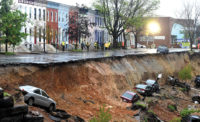Relief operations in central Europe and in China’s Henan province remain in full swing as authorities assess major damage to infrastructure and their economies following record rain-induced flooding last month. Fatalities exceed 200 in Germany and Belgium, with about 63 reported dead in China.
Germany's federal government on July 21 approved a package of emergency flood aid, adding to what will be a $471.6 million initial boost as western regions reel from days of flash flooding along borders with Belgium and the Netherlands, with the regional death toll over 200 and transportation and other infrastructure sustaining heavy damage in some areas.
The floods follow hard and constant mid-month rains, leading small regional rivers to burst their banks, including the Ahr, Meuse, Maas and Wupper. While the key Rhine River also rose, causing disruption in shipping, most damage seems to have come from smaller rivers and tributaries.
The initial German aid package is meant to cover immediate damage to buildings and local infrastructure and to help citizens in crisis situations, with Finance Minister Olaf Scholz calling the floods a “disaster of national proportions.”
According to Germany's government-owned railway operator Deutsche Bahn, more than 50 bridges, 180 level crossings, 40 signal boxes, more than 1,000 electric and signal masts, as well as energy and lighting systems and station elevators were damaged.
“Never before has our infrastructure been destroyed to this extent in one go,” Volker Hentschel, a board member of its infrastructure division, told the Associated Press, with an initial $1.5-billion damage estimate. He said full restoration of the national system will take “months, if not years,” but believes repairs to 80% of can be made by year end.
It‘s still unclear how many roads and bridges are damaged or destroyed in Rhineland-Palatinate, the heaviest-hit area. The regional roads authority expects its first real assessment not until the middle of next week. The German army has been called in to deploy a temporary bridge in one small town.
Germany also may apply for European Union infrastructure repair assistance, Scholz said. This is the first step in what will be an extensive rebuilding effort, with reconstruction set to run into the billions.
The floodwaters smashed power and water utility sites, opened large sinkholes and damaged travel routes. The university at Bonn-Rhein-Sieg estimated damage in the millions, with 6 feet of water in basements and the heating, building control, servers and main power supply destroyed.
Broader damage assessments and infrastructure planning are ongoing as cleanup efforts continue.
A spokeswoman for the main German construction industry association said the group undertook efforts to survey and coordinate heavy equipment use and cleanup work in securing roads, slopes, residential areas and bridges.
Central China’s Henan province recorded the worst flooding in decades, with its largest city Zhengzhou noting 201.9 mm of rainfall and inundation of a key subway line that killed at least 12 people as 500 had to be rescued.
Raging rainwater tore through a tunnel between two stations of the 40.4-km Line 5. There were reports of at least eight power generating substations knocked out and four major water plants forced to halt operation.
Chinese soldiers were ordered to reinforce the Changzhuang reservoir in Zhengzhou to avert collapse and blast the Yihetan dam in Luoyang to divert floodwater.
China has not officially stated the flood’s economic impact, but AP estimated it at about $2 billion.
Much local and international reporting on the flooding places it in the context of climate change, connecting patterns of extreme weather events.
German Environment Minister Svenja Schulze called for greater financial resources to address extreme weather events caused by climate change and favors adding required adaptations to the country's laws, says Reuters.
Christian Albert, an environmental analysis and metropolitan planning expert at the University of Bochum's Institute of Geography in the German state of North Rhine-Westphalia, sees further climate-change related flooding events ahead. Technology-based risk reduction measures will be important, he says, but not enough on their own.
The hard-hit Rhineland area is marked by decades—and in some cases much longer—of landscape interventions, including wholesale changing and constriction of waterways, according to Albert. As more and more land is built on and sealed, rainwater has a harder time draining and runs off quickly, raising the risk of inundation.
As the rebuild gets underway, he says nature-based strategies should be included, such as reconnecting oxbow lakes and riverbends by lowering river banks; making more space for rivers; and ensuring wider marginal strips on the side of agricultural fields, which reduces soil erosion and makes it easier for water to drain. Most of the damage from last week’s floods occurred in hilly areas from stormwater coming down through creeks.
But with federal elections in Germany in September, hard questions are being asked about why flooding was so lethal and whether flood preparation and warning systems were up to task.
“There are many things coming together: extreme precipitation, flood risk, and we have restructured landscapes with non-permeable soils. We’ve straightened our rivers, cut them off from historic flood plains,” Albert says. “Both in housing and infrastructure development we need to be more cautious about the impact of flooding in the future.”
Chinese transport and water ministries presented reports at a virtual conference in June chaired by China Premier Li Keqiang that related to future work in flood control and prevention, emergency rescue and disaster relief.
No strategy details were released by the government.




Post a comment to this article
Report Abusive Comment